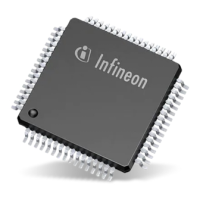Introduction to Digital Power Conversion
XMC4000/1000 Family
Converter Topologies
Application Guide 17 V1.0, 2015-01
3.1 Buck
A Buck converter can only generate lower output average voltage (V
OUT
) than the input voltage (V
IN
),
and is therefore also referred to as a “Step-Down” converter.
The DC/DC conversion is non-isolating, in the sense that there is a common ground between input
and output. Some improved versions exist:
Figure 5 Buck
Interleaved Buck Converter
When reduced ripple and smaller components are required, especially in high-voltage applications,
then a realistic approach is to interleave the output currents from a multiphase Buck converter stage.
For example a 2-phase Buck converter controlled by fixed 180
o
phase-shifted PWM from an XMC
CCU4/8
Synchronous Buck Converter
When reduced power conversion loss is required, the rectifying diode D may be replaced by an active
switch that can offer a lower voltage drop. In such a solution the rectification will be synchronously
invoked by a signal that is complementary to the control signal, from a CC8 timer or CC4 timer pair.
Inverted Buck Converter
When a simplified current measurement is required, then an Inverted Buck controller is an alternative,
assuming common ground between input and output voltage is not necessary. By sensing the voltage
over a resistor (R) to ground, the inductor current (I
L
) can be monitored by a VADC or ACMP.

